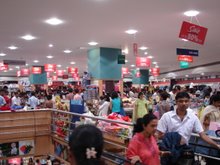Pushy salesmen lead to customer dissatisfaction
INFINITY Retail, the joint venture between Tata Sons and Woolworths, has started off in durables retailing with Croma, stocking nearly 6,000 products in multiple categories. The first two Croma stores are already operational and Infinity Retail expects to start another 28 in the next 12 months. Infinity Retail CEO Ajit Joshiwho was formerly vice-president, operations, Shoppers Stop, spoke to ETabout challenges of durables retailing. Excerpts:
There are many international formats in durable retailing. Which one did you look at for Croma?
The model that we have adopted is similar to Australian retailer Dick Smith Electronics’ ‘Powerhouse’ chain, whose stores are 15,000-20,000 square feet large. We’ve tweaked it for India. We have adapted the height to store the same number of SKUs. By having displays and prominently highlighting product information within the store, we’re actually reducing service time since people can make buying decisions quicker. We’re also sticking with a consistent pricing policy — we would like to offer the best price everyday, and go in for deep discounting since we don’t want any customer to lose out.
Will you look at leveraging distribution network using Woolworth’s backbone or use the disruptive potential that Woolworth’s sourcing brings?
Yes, durables retailing is largely a distributor-driven business. We could disrupt the chain using Woolworth’s backbone — I could go directly to the manufacturer and pass on the benefits to consumers. But the channel is very well-established and perhaps the best existing channel. So Woolworth’s would like to capitalise on the strength of the existing channel. If a dealer has a customer who wants 100 TV sets, we can tell him, we want 500 TV sets, now can you look at your margins differently and give us what you have on priority? We are looking at managing the chain rather than acting as a disruptive force.
How does your business get affected by the tax regime, in which CST still hasn’t been phased out?
We can’t have a national hub and spoke model. We would have ideally liked to have a centralised hub like Woolworth’s has in Australia. Just one distribution centre services nearly 600 stores all over Australia. For Croma, Woolworth’s does the stock-keeping, the warehousing and the sourcing. Woolworth’s has to move it from hub to hub. For a stock transfer from a Croma store in Mumbai to our upcoming one in Ahmedabad, we have to pay octroi. In the NCR, I would love to have 15-20 stores, but these are three different states, so I need to have three different distribution centres. To improve efficiency, I have to make sure that my distribution centre doesn’t lose money and service at least eight stores one DC. A state like Gujarat with its fantastic road network will definitely make it easier for us to service 15 stores from one distribution centre that Woolworth is opening there.
What are the challenges in durables retail today that you’re looking to address in Croma?
The biggest challenge is in getting the range right, since that is a huge source of customer dissatisfaction. Customers don’t always get everything that they find in some catalogue. We’ve got nearly 40-45 brands of laptops but do we have the entire range? Perhaps not, since we don’t keep assembled models. Today, we have nearly 180 brands in our two stores. Salespeople in other durables chains work on a commission basis. We felt that isn’t right and we give the sales force fixed salaries. They then leave the customer alone because he has no incentive to push any particular brand and will only help when he’s asked. Pushy salespeople are a huge source of customer dissatisfaction. If our customers say we want to check prices at a competing store we encourage them to do it, but if a salesperson was hired on commission he would have started bargaining with the customers.
A good after-sales service is vital for the business. What measures have you adopted in this area?
We try and ascertain customer requirements and then recommend a product. Our team has often gone to people’s homes to recommend exactly what sort of TV size is required for families. At times we also invite architects to design kitchen platforms. They then suggest what would bethe best fridge as per the design or requirements. When our customers come back with their goods, Croma is their only point of contact. So we’re following up for the customers ourselves rather than them chasing the company.
Lots of department stores and hypermarkets too have a segment purely for consumer durables even if it doesn’t have a similar range. How do you reckon that will play out?
If a person is going to buy shirts and ties, he probably won’t pick up a toaster at the same time. It’s (durables buying) always a planned, organised purchase when it comes to durables.They are still bought as a family decision. You’ll still get kids coming into the store when parents come to the store and they’re part of decision making. We have to create a family store and avoid the trap of making it a “man’s toy store.”
How would you deal with realty costs, especially after the budget brought commercial rental income under the service tax net?
I think flexibility in formats is very important. Most of our large formats will be in the region of 15,000 - 22,000 square ft. We are opening a store in Churchgate (South Mumbai) and we naturally won’t get that sort of space, so we’re adapting the format. We want to offer a full width and range in every store.
Courtesy: EconomicTimes
For more details on Retail India visit: www.retailindia.tv



No comments:
Post a Comment